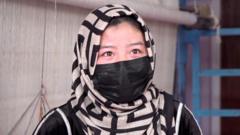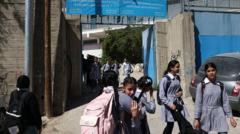Afghan girls, previously denied education and numerous job opportunities, now find themselves in the carpet weaving industry, a rare vocational avenue still permitted under Taliban rule.
New Opportunities Amidst Adversity: Afghan Girls Embrace Carpet Weaving

New Opportunities Amidst Adversity: Afghan Girls Embrace Carpet Weaving
The school ban by the Taliban has driven Afghan girls to carpet weaving as a means of survival.
In a stifling workshop in Kabul, 19-year-old Salehe Hassani recounts how the banning of education for girls over 12 has forced many like her to look for alternative means to support themselves. The return of Taliban governance in 2021 led to a significant drop in women’s workforce participation, leaving low-paid labor as one of the few options available to these young women.
Carpet weaving, although a traditional craft, has become a critical source of income for approximately 1.2 to 1.5 million Afghans, particularly given that nearly 90% of the workers are women. A recent UN report highlights that the economic crisis in Afghanistan has exacerbated the situation, with fewer opportunities for livelihood pushing women into exhausting days of weaving, despite the industry’s booming export business.
In the first half of 2024, Afghan carpet exports exceeded 2.4 million kilograms, generating over $8.7 million in revenue. However, weavers often see little of this profit; many earn less than a dollar a day for their extensive labor. Nisar Ahmad Hassieni, head of a carpet manufacturing company, insists on fair payment, offering between $39 and $42 for each square meter of carpet produced, yet the overall earnings remain meager.
In this grim environment, young women such as Shakila, once hopeful about law or journalism careers, are forced into manual labor instead, often supporting entire families. The traumatic backdrop of school bombings in 2021 has deepened their resolve to seek education, despite its current unavailability. The enduring spirit of these women shines through as they pursue knowledge independently; Salehe, for instance, continues to study English with dreams of becoming a physician in Afghanistan.
As these Afghan girls weave carpets, they stitch together hopes and dreams, defying the restrictions placed upon them, symbolizing resilience amidst adversity. The journey reflects both their struggle and determination, painting a poignant picture of courage in the face of systemic challenges.
Carpet weaving, although a traditional craft, has become a critical source of income for approximately 1.2 to 1.5 million Afghans, particularly given that nearly 90% of the workers are women. A recent UN report highlights that the economic crisis in Afghanistan has exacerbated the situation, with fewer opportunities for livelihood pushing women into exhausting days of weaving, despite the industry’s booming export business.
In the first half of 2024, Afghan carpet exports exceeded 2.4 million kilograms, generating over $8.7 million in revenue. However, weavers often see little of this profit; many earn less than a dollar a day for their extensive labor. Nisar Ahmad Hassieni, head of a carpet manufacturing company, insists on fair payment, offering between $39 and $42 for each square meter of carpet produced, yet the overall earnings remain meager.
In this grim environment, young women such as Shakila, once hopeful about law or journalism careers, are forced into manual labor instead, often supporting entire families. The traumatic backdrop of school bombings in 2021 has deepened their resolve to seek education, despite its current unavailability. The enduring spirit of these women shines through as they pursue knowledge independently; Salehe, for instance, continues to study English with dreams of becoming a physician in Afghanistan.
As these Afghan girls weave carpets, they stitch together hopes and dreams, defying the restrictions placed upon them, symbolizing resilience amidst adversity. The journey reflects both their struggle and determination, painting a poignant picture of courage in the face of systemic challenges.






















